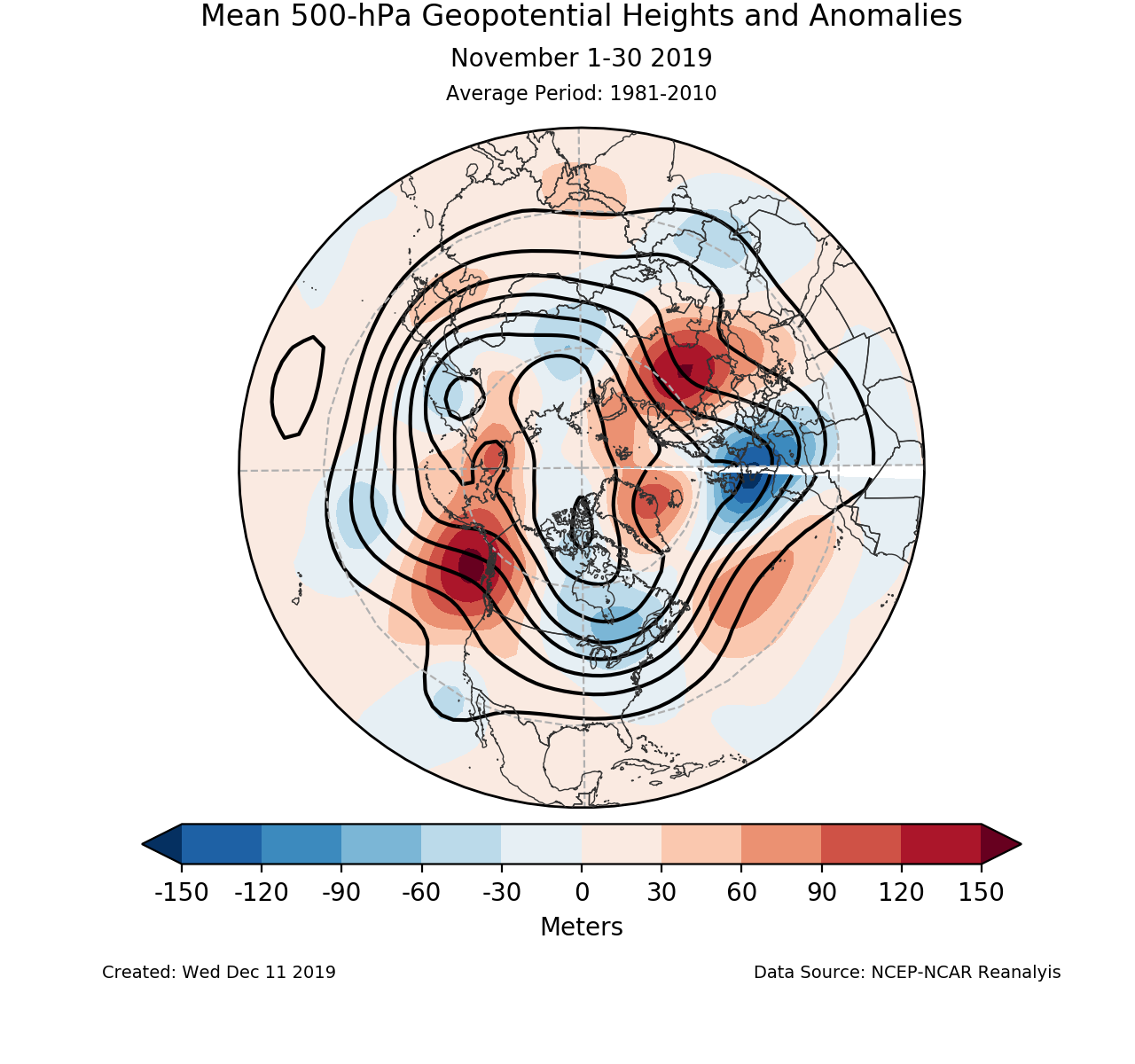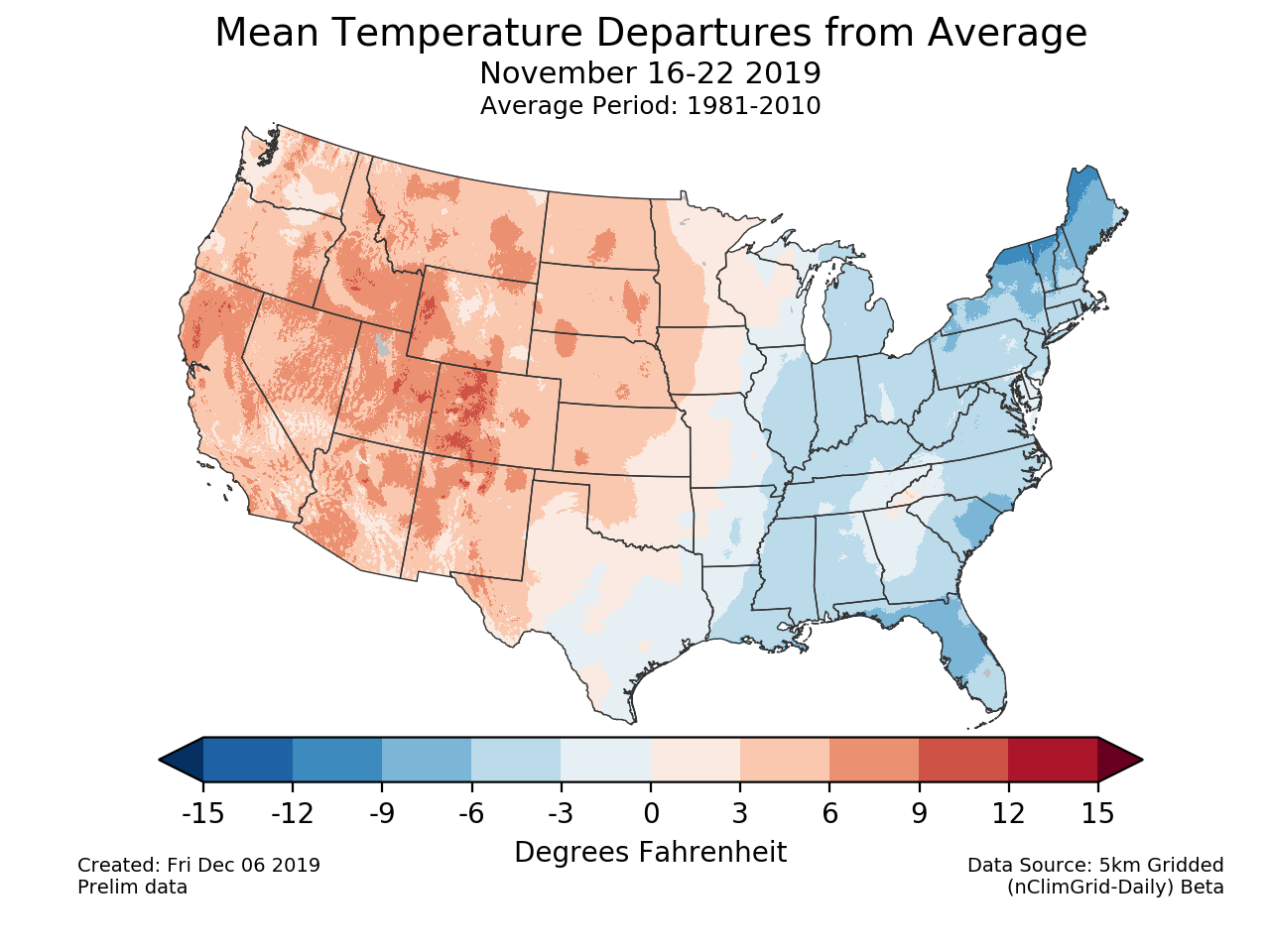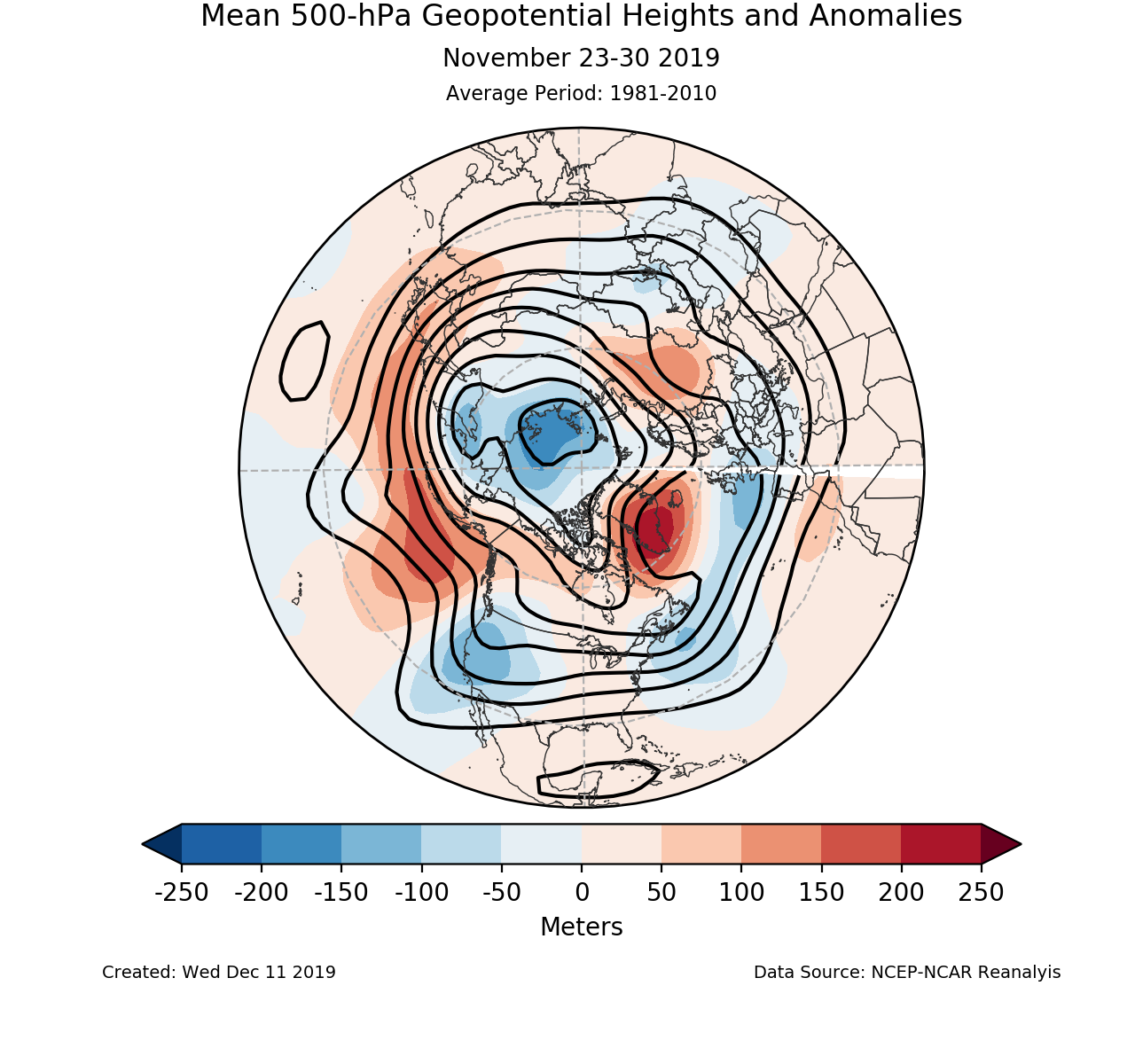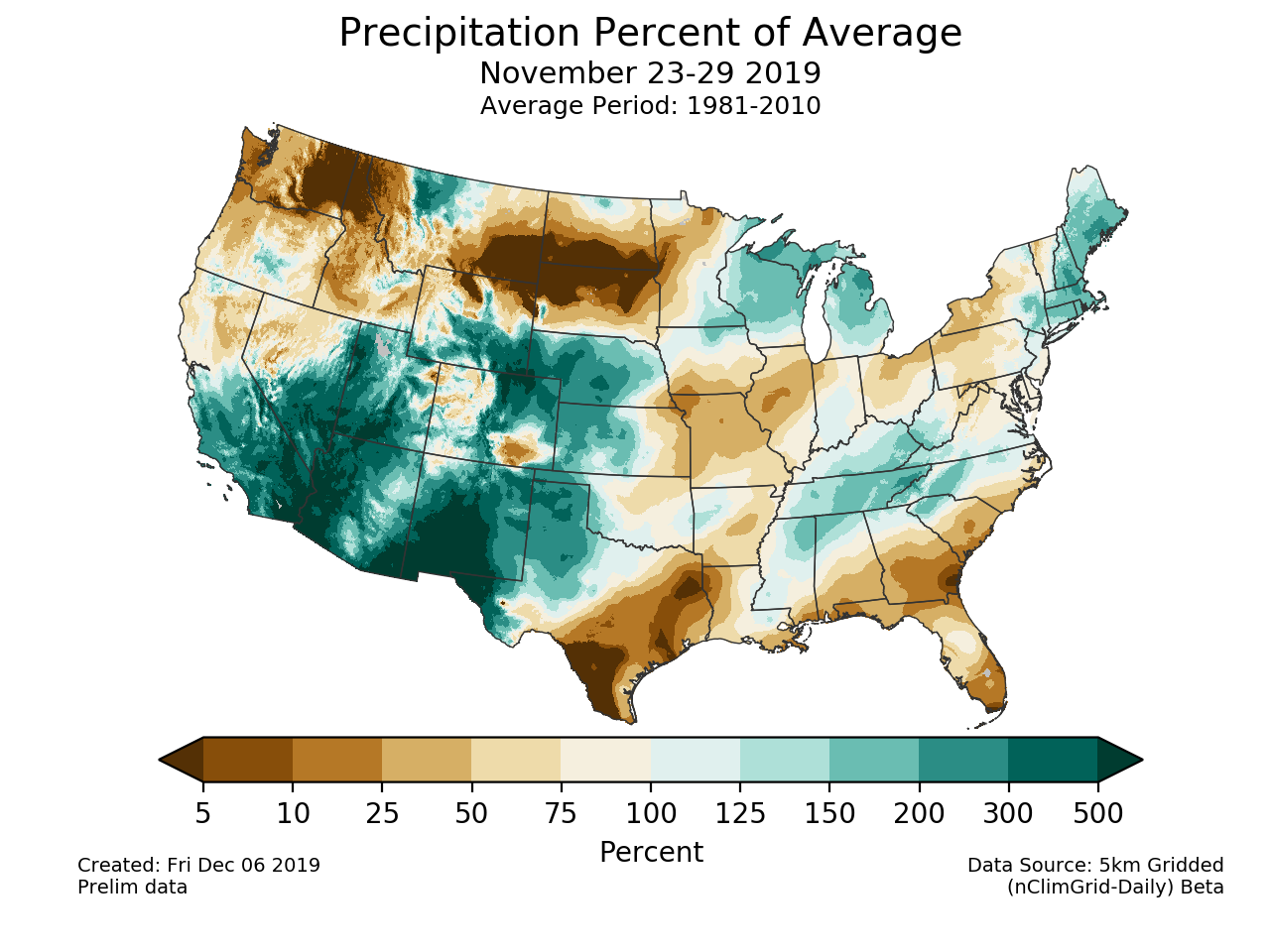Note: This Synoptic Discussion describes recent weather events and climate anomalies in relation to the phenomena that cause the weather. These phenomena include the jet stream, fronts and low pressure systems that bring precipitation, high pressure systems that bring dry weather, and the mechanisms which control these features — such as El Niño, La Niña, and other oceanic and atmospheric drivers (PNA, NAO, AO, and others). The report may contain more technical language than other components of the State of the Climate series.
Summary
| Time Period | Key Driver | Other Drivers |
|---|---|---|
| Month | WPO- | EPO-, AO- |
| November 1-15 | WPO- | EPO-, AO- |
| November 16-22 | Tropical Storm Raymond | |
| November 23-30 | El Niño | NAO-, EPO- |
The weather in November 2019 was dominated by upper-level ridges along the West Coast and troughs near the Great Lakes. This pattern was particularly strong during the first half of the month. Scarcely any precipitation fell westward from the Rockies under the grip of the ridge. Locations east of the Rockies experienced colder than normal temperatures with the trough. The orientation of these features aligns well with the weakened Pacific jet associated with the negative phases of both the West Pacific Oscillation (WPO) and the East Pacific Oscillation (EPO).
Those blocking patterns broke down in the second half of the November and led to more variable weather patterns. A cutoff trough associated with the remnants of Tropical Storm Raymond was the primary driver behind the above-normal precipitation for much of the Southwest in November. Near the end of the month, the pattern looked more like a typical El Niño pattern. A Bomb Cyclone formed off the Pacific Coast. It moved eastward bringing holiday travel disruptions in its wake.
Monthly Mean
Submonthly Evolution
November 1-15
The first half of November featured an enhanced ridge extending from the Southwest US to Alaska. The northwest-to-southeast tilt of this ridge was typical of the negative phase of the West Pacific Oscillation (WPO) pattern. The ridge was associated with moderately above normal temperatures over the western US. It also prevented nearly any precipitation falling from the Rocky Mountains westward. The downstream trough near the Great Lakes was associated with widespread cooler than normal temperatures east of the Rockies. A particularly strong cold surge happened around November 11-13. Precipitation was generally near-to-below average around the trough as well with limited pockets of wetter conditions.
November 16-22
Near the middle of the month, a trough moved eastward from Russia and displaced the Alaskan ridge. This pattern featured a stronger Pacific jet, which allowed for more propagating weather patterns. A trough in the subtropical jet moved eastward from Baja to Florida. It brought Florida its first cooler than normal temperatures in months. Another cutoff low developed in association with the remnants of Tropical Storm Raymond. This system ended the dry conditions of the previous weeks and brought winds, heavy rains, and flooding to the Desert Southwest November 19-20.
November 23-30
The ridge returned to the Gulf of Alaska for the final week of November but with a southwest-to-northeast tilt. That allowed a trough to remain over the West Coast, bringing below-normal temperatures and above-normal precipitation to the Southwest. A "Bomb Cyclone" formed off the Pacific Coast with this trough and had major impacts on travel for the Thanksgiving holiday as it moved eastward.
Atmospheric Drivers
- El Niño Southern Oscillation (ENSO)
- Description: Oceanic and atmospheric conditions in the tropical Pacific Ocean can influence weather across the globe. ENSO is characterized by two extreme modes: El Niño (warmer-than-normal sea surface temperature [SST] anomalies in the tropical Pacific) and La Niña (cooler-than-normal SST anomalies), with the absence of either of these modes termed “ENSO-neutral” conditions. These variations in SST change the locations of the Pacific's largest thunderstorms, which can in turn change circulation patterns around the globe.
- Status: The ocean and atmosphere system continued to be in ENSO-neutral during November 2019. The most common metric for ENSO is the SST anomalies in the Central Pacific, the Niño 3.4 region. These have been moderately warm in October and November after being near-zero in August and September. However, a much longer period of warming along with more substantial atmospheric coupling would be required for a return to El Niño conditions.
- Teleconnections (influence on weather): The teleconnections with ENSO are muted during near-neutral conditions. An active El Niño would have favored cooler than normal temperatures in the southwest, which only appeared during the final week of the month. It would have also favored wetter conditions over the southern half of the country, which also only occurred toward the end of the month.
- Madden-Julian Oscillation (MJO)
- Description: The MJO is the biggest source of subseasonal (30-60 day) tropical variability. It typically develops as a large envelope of tropical thunderstorms that develops over the Indian Ocean that then moves eastward. Like ENSO, the MJO's effects on tropical rainfall is so strong that it can alter the atmospheric circulation around the globe. The thunderstorms decay when they cross the Pacific, but the associated winds can often continue across the Western Hemisphere to initiate the next MJO in the Indian Ocean. The MJO is episodic, meaning that is not always active. Most indices for tracking the MJO identify both the MJO's amplitude and the longitude of its strongest rainfall, usually described as one of eight phases.
- Status: The MJO was very active for the first half of November. It began the month over the Maritime Continent (Phase 5) and made its typical eastward propagation across the western Pacific (Phase 6/7) and the Western Hemisphere (Phase 8/1). The MJO slowed to a halt towards the end of the month as it interacted with the strongly positive Indian Ocean Dipole (IOD).
- Teleconnections (influence on weather): The MJO's movement across the western Pacific during the middle of November would typically favor cooler than normal conditions near the Great Plains, but those primarily occurred earlier in the month.
- The Pacific/North American (PNA) pattern
- Description: The PNA teleconnection pattern is associated with strong fluctuations in the strength and location of the East Asian jet stream. PNA-related blocking of the jet stream flow in the Pacific can affect weather downstream over North America, especially the West and especially in the winter half of the year.
- Status: The daily PNA index began November negative, spent most of the month as weakly positive, and then returned to weak negative values in the final week. On average, the PNA was neutral during November 2019 because the wavetrain including the trough in the central North Pacific, the ridge in the Gulf of Alaska, and the Trough near the Great Lakes was out of the phase with the canonical PNA wavetrain.
- Teleconnections (influence on weather): The negative PNA early in the month would generally favor below-normal temperatures along the West Coast and warmer temperatures over the Southeast. Instead, temperatures were moderately warmer than usual in the Western US and cooler than normal for most of the East.
- The Arctic Oscillation (AO) pattern
- Description: The AO teleconnection pattern generally measures the pressure difference between the low pressure over the North Pole and the higher pressures in the subtropical ridges. This pressure difference is larger during a positive AO, resulting in a stronger midlatitude jet. When the AO is negative, the jet is weaker and will have larger troughs and ridges.
- Status: The AO was negative for almost the entire month, primarily in association with the ridge over Greenland and the trough near northwestern Europe.
- Teleconnections (influence on weather): The positive AO during the first half of November would typically be associated with cooler than average temperatures from the Northern Plains to the East Coast, which were particularly prevalent in the first half of the month.
- The North Atlantic Oscillation (NAO) pattern
- Description: The NAO teleconnection pattern relates the pressure over the sub-polar low near Greenland and Iceland with the subtropical high over the Central Atlantic. It significantly affects the weather on both sides of the Atlantic.
- Status: The daily NAO was neutral or weakly positive for most of the month before becoming negative in the final week. The positive values early in the month were largely due to the ridge over the central North Atlantic, but it was likely tempered by the lack of a trough over Greenland. In the final week of the month, the ridge shifted northward over Greenland and was replaced by the canonical trough over the North Atlantic.
- Teleconnections (influence on weather): The NAO's impacts on the CONUS are generally weaker during the fall months. However, the negative NAO at the end of the month likely played a role in the trough near the East Coast
- The West Pacific Oscillation (WPO) pattern
- Description: The WPO teleconnection pattern is a primary mode of low-frequency variability over the North Pacific and reflects zonal and meridional variations in the location and intensity of the East Asian jet stream in the western Pacific.
- Status: The daily WPO index began the month strongly negative before shifting to weak positive values during the latter half of the month. The monthly average was negative, due primarily to the the enhanced ridge over northeastern Russia and the trough to its south. These patterns reversed in the final week of the month.
- Teleconnections (influence on weather): The negative WPO is typically associated with cooler than normal temperatures over the Northern Plains, which featured prominently in the first half of the month. Similarly, the warm anomalies in the Northern Plains near the end of the month were consistent with the positive WPO.
- The East Pacific Oscillation (EPO) pattern
- Description: The EPO pattern identifies variations in the strength and location of the eastern Pacific jet stream. During the positive phase, the jet is stronger and shifted southward. The negative phase is associated with an Alaskan ridge that weakens the jet. The EPO is closely related to the East Pacific–North Pacific (EP–NP) teleconnection pattern, although the two are defined with opposite signs.
- Status: The daily EPO index was strongly negative at the beginning of the month, neutral during November 16-22, and then negative again at the end of the month. Averaged over November, the EPO was strongly negative. The fluctuations largely followed the ebb and flow of the Alaskan ridge, which was very strong early in the month and returned later on. However, that ridge was never really stacked meridionally north of a trough as would be more typical of a negative EPO.
- Teleconnections (influence on weather): The negative phase of the EPO favors cooler than normal temperatures across the Upper Midwest and Northeast. This pattern was particularly apparent in the first half of the month.
 NOAA's National Centers for Environmental Information
NOAA's National Centers for Environmental Information
















